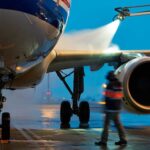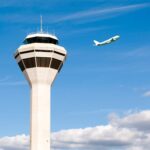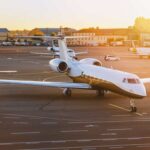
Key Takeaways
- Wake turbulence is a type of disturbance in the air caused by the passage of an aircraft, primarily at lower altitudes during takeoff and landing.
- Private jets, being lighter and smaller, can be more susceptible to wake turbulence than larger commercial aircraft.
- Flight altitude plays a crucial role in turbulence experience; private jets often cruise at higher altitudes where the air is less turbulent.
- Pilots of private jets have more flexibility to change course and altitude to avoid turbulence, enhancing passenger comfort.
- Safety measures, including air traffic control guidelines and pilot training, are in place to mitigate the risks of wake turbulence.
Up in the Air: The Dynamics of Private Jet Wake Turbulence
Imagine you’re gliding smoothly at 40,000 feet, sipping on a glass of champagne, when suddenly your private jet hits a patch of rough air. The unexpected jolts and drops are the handiwork of an invisible force known as wake turbulence. It’s a natural phenomenon, but understanding it is key to ensuring your flight is as safe and comfortable as possible.
Defining Wake Turbulence and Its Causes
When an aircraft slices through the air, it leaves a swirling mass of air behind its wingtips and tail. This is called wake turbulence. These vortices of air can linger long after the plane has passed and can pose a challenge for other aircraft that encounter this disturbed air. The strength of wake turbulence is influenced by the weight, size, and speed of the aircraft, as well as the shape of its wings.
Think of it like the wake behind a boat; the larger the boat, the bigger the wake. Similarly, a large airliner will create more significant turbulence than a small private jet. But don’t let this analogy fool you; despite their size, private jets can still pack a punch when it comes to creating wake turbulence.
Why It Matters for Your Flight Comfort and Safety
So why should you care about wake turbulence? Because it affects two critical aspects of your flight experience: comfort and safety. Turbulence can range from a mild annoyance, disrupting your relaxation, to a severe safety hazard, potentially causing loss of control or structural damage to the aircraft following too closely behind. That’s why understanding wake turbulence is not just about smooth flying; it’s about ensuring that every aspect of your flight is managed with the utmost regard for safety.
Let’s dive into the specifics of how private jets experience wake turbulence differently from their larger commercial counterparts and what that means for you as a passenger.
Comparing the Skies: Private Jet vs. Commercial Aircraft Turbulence

While both private jets and commercial aircraft must contend with wake turbulence, their experiences differ due to several factors. The first is size and weight. Private jets are typically lighter and smaller than commercial airplanes, which means they can be more affected by the vortices created by large aircraft. This is because a lighter aircraft has less inertia to counter the disturbances caused by the wake of a preceding plane.
Size and Weight Differences Explained
The physics is straightforward: heavier and larger aircraft displace more air, and thus, create stronger wake turbulence. Private jets fall into a category where they create less wake turbulence but are also more vulnerable to it. This vulnerability is not just about comfort; it’s about the ability to maintain a smooth and controlled flight path.
Flight Altitude: A Key Factor
Another key factor is the cruising altitude. Private jets often fly higher than commercial airliners, which means they can avoid much of the turbulence that occurs at lower altitudes. At higher altitudes, the air is thinner and produces less resistance against the aircraft, leading to a smoother ride. Therefore, while private jets may be more susceptible to wake turbulence, they also have the advantage of reaching smoother air faster.
Feeling the Bumps: How Private Jet Wake Turbulence Affects Your Journey
The Impact on Passenger Experience
For passengers, the experience of wake turbulence in a private jet can be more pronounced than in a commercial aircraft. This is due to the smaller size and weight of private jets, which allows passengers to feel the turbulence more directly. However, the duration of these uncomfortable moments is typically shorter, as private jets can climb quickly to higher, less turbulent altitudes.
Understanding How Pilots Handle Turbulence
Pilots are trained to deal with turbulence, including wake turbulence. They use a combination of experience, training, and technology to navigate through or around areas of rough air. Pilots can adjust the altitude or change the flight path to find smoother conditions, ensuring that passengers remain as comfortable as possible.
The Safety Measures: Mitigating Wake Turbulence Risks

When it comes to safety, the aviation industry takes wake turbulence seriously. A variety of measures are in place to minimize the risks associated with it.
Private Jet Piloting Techniques and Weather Forecasting
Private jet pilots have a range of techniques at their disposal to avoid wake turbulence. They are adept at interpreting weather patterns and forecasts to plan the smoothest possible route. Advanced onboard radar and communication with air traffic control allow pilots to be aware of potential turbulence before encountering it, allowing for timely adjustments to the flight path.
Regulatory Guidelines for Spacing and Flight Paths
Regulatory bodies such as the Federal Aviation Administration (FAA) and the International Civil Aviation Organization (ICAO) set guidelines for minimum separation distances between aircraft to prevent wake turbulence encounters. These regulations ensure that an aircraft has enough time to clear the airspace before another enters the same path, significantly reducing the risk of wake turbulence incidents.
Smoother Skies Ahead: Strategies for Passenger Comfort
Despite the physics of wake turbulence, there are strategies that can be employed to ensure passenger comfort on private jets.
Pre-flight Preparation and Tips for Passengers
Pre-flight preparation is crucial. Passengers can minimize the impact of turbulence by:
- Following the pilot’s instructions regarding seat belts.
- Stowing loose items securely.
- Choosing seats closer to the center of the aircraft where movement is less pronounced.
How In-Cabin Features Alleviate Turbulence Discomfort
Modern private jets are equipped with features designed to reduce the discomfort caused by turbulence. These include state-of-the-art stabilization systems that automatically adjust to sudden movements, and cabin designs that provide a more comfortable and relaxing environment.
Frequently Asked Questions (FAQ)
Here are some common questions about private jet wake turbulence:
What Exactly Is Wake Turbulence and How Is It Generated?
Wake turbulence is the disturbed air left behind an aircraft as it flies through the atmosphere. It is generated by the lift created by the wings and the drag produced by the aircraft body. The intensity of wake turbulence is dependent on the size, weight, and wing configuration of the aircraft.
How Does the Size of an Aircraft Affect Its Experience of Wake Turbulence?
The size of an aircraft affects both the wake turbulence it generates and its susceptibility to wake turbulence created by others. Larger aircraft generate stronger wake turbulence, while smaller aircraft, like private jets, are more susceptible to experiencing turbulence caused by others.
At What Altitudes Is Wake Turbulence Most Common for Private Jets?
Wake turbulence is most common at lower altitudes, particularly during takeoff and landing phases of flight. However, private jets typically climb quickly to higher altitudes where the air is smoother and wake turbulence is less of a concern.
What Are Some Safety Protocols in Place to Prevent Wake Turbulence Accidents?
Safety protocols include air traffic control maintaining minimum separation distances between aircraft, pilot training on wake turbulence avoidance, and the use of advanced radar systems to detect and avoid turbulent areas. For more detailed information on what regulations apply when flying on a private jet, passengers can educate themselves to ensure a safe journey.
Can Passengers Do Anything to Minimize the Effects of Turbulence During Flight?
Yes, passengers can help minimize the effects of turbulence by:
- Always keeping their seatbelt fastened when seated, as recommended by turbulence safety guidelines.
- Listening to the flight crew’s instructions.
- Staying seated during turbulent periods.
Remember, while turbulence can be an uncomfortable part of flying, the aviation industry has developed comprehensive strategies to manage it effectively, ensuring your flight is as safe and comfortable as possible.
Wake turbulence is an unavoidable byproduct of flight, yet it’s one that can be managed effectively to ensure a safe and pleasant travel experience. Whether you’re flying on a private jet or a commercial aircraft, understanding the nuances of wake turbulence is essential. Remember, the key to a comfortable flight lies not only in the aircraft’s design and the pilot’s expertise but also in your own preparedness as a passenger.
What Exactly Is Wake Turbulence and How Is It Generated?
Wake turbulence is akin to the ripples caused by a stone thrown into a pond; it’s the disturbance in the air left behind by an aircraft in flight. Generated by the lift over the wings and the drag from the body of the aircraft, wake turbulence can be a potent invisible trail, especially from large aircraft. The whirling air masses, known as vortices, can persist for several minutes, posing a challenge to following aircraft.
The intensity of these vortices is primarily influenced by the plane’s weight, speed, and wing shape. Heavier and faster aircraft with large wingspans, like commercial airliners, will produce more significant wake turbulence than lighter, more agile private jets. However, the latter’s smaller size means they can feel the effects of turbulence more acutely, making it an important consideration for pilots and passengers alike.
How Does the Size of an Aircraft Affect Its Experience of Wake Turbulence?
The size of an aircraft directly impacts its experience with wake turbulence. Larger planes, with their heavier mass and broader wingspans, create powerful vortices that can unsettle smaller aircraft trailing behind them. On the flip side, smaller aircraft, such as private jets, are more responsive to these air movements, feeling the effects more pronouncedly.
This is particularly noticeable when a private jet is taking off or landing behind a larger aircraft. The lighter weight and smaller size of the jet mean that it requires skillful piloting to navigate through the invisible turbulence without discomfort or risk to the passengers.
Therefore, understanding the size and weight of your aircraft in relation to others sharing the skies is crucial. Pilots of private jets are well-versed in these dynamics and take proactive measures to avoid wake turbulence, ensuring a smoother ride for those onboard.
- Heavier, larger aircraft create stronger wake turbulence.
- Smaller, lighter aircraft like private jets are more affected by wake turbulence.
- Pilots must be particularly cautious during takeoff and landing phases.
At What Altitudes Is Wake Turbulence Most Common for Private Jets?
Wake turbulence is most prevalent at lower altitudes, where aircraft are taking off or landing. This is when planes are at their slowest and the vortices created by their wings are at their strongest. Private jets, with their capability to ascend quickly, usually bypass these turbulent zones swiftly, climbing to smoother, higher altitudes where the air is less disturbed.
What Are Some Safety Protocols in Place to Prevent Wake Turbulence Accidents?
One of the most critical safety protocols for preventing wake turbulence accidents is the use of strategic air traffic control (ATC) separation standards. ATC assigns time and distance buffers between takeoffs and landings to ensure that any wake turbulence dissipates before the next aircraft enters the area.
In addition to ATC regulations, pilots receive specialized training to handle and avoid wake turbulence. This includes understanding the performance characteristics of their aircraft, recognizing potentially hazardous situations, and knowing how to react swiftly and effectively.
Technology also plays a pivotal role. Modern aircraft are equipped with advanced navigation and weather prediction tools that help pilots anticipate and avoid areas where wake turbulence could be a factor.
Collectively, these measures create a multi-layered defense against the risks posed by wake turbulence, ensuring that your journey in the skies is as safe as possible.
Can Passengers Do Anything to Minimize the Effects of Turbulence During Flight?
As a passenger, there’s a lot you can do to minimize the effects of turbulence. Here are some practical tips:
- Always keep your seatbelt fastened when seated, even if the seatbelt sign is off.
- Pay attention to the pre-flight safety briefing, as it contains important information about what to do during turbulence.
- Store carry-on luggage properly to prevent it from causing injury during sudden turbulence.
- If you’re feeling anxious, inform the cabin crew who can assist you and provide reassurance.
By following these guidelines, you can contribute to a safer and more comfortable flight experience for yourself and your fellow passengers. Remember, turbulence is a normal part of flying, but with the right precautions and an informed crew, it doesn’t have to be a cause for concern.
In conclusion, wake turbulence is an element of physics that pilots and passengers must respect. While it poses a greater challenge for lighter and smaller aircraft like private jets, the aviation industry’s robust safety measures and the agility of these aircraft ensure that wake turbulence is nothing more than a momentary bump on your journey through the skies. So, sit back, relax, and trust that your flight crew has everything under control.
Understanding the effects of wake turbulence is crucial for all aircraft, but it’s particularly important for private jets due to their size and the altitudes at which they operate. Wake turbulence occurs when an aircraft in flight generates a series of vortices behind it. This phenomenon can be especially hazardous during takeoff and landing phases, where the distance between aircraft is at its minimum. Private jets, often being lighter than their commercial counterparts, can be more susceptible to these disturbances, hence pilots must be well-versed in wake turbulence avoidance strategies.










